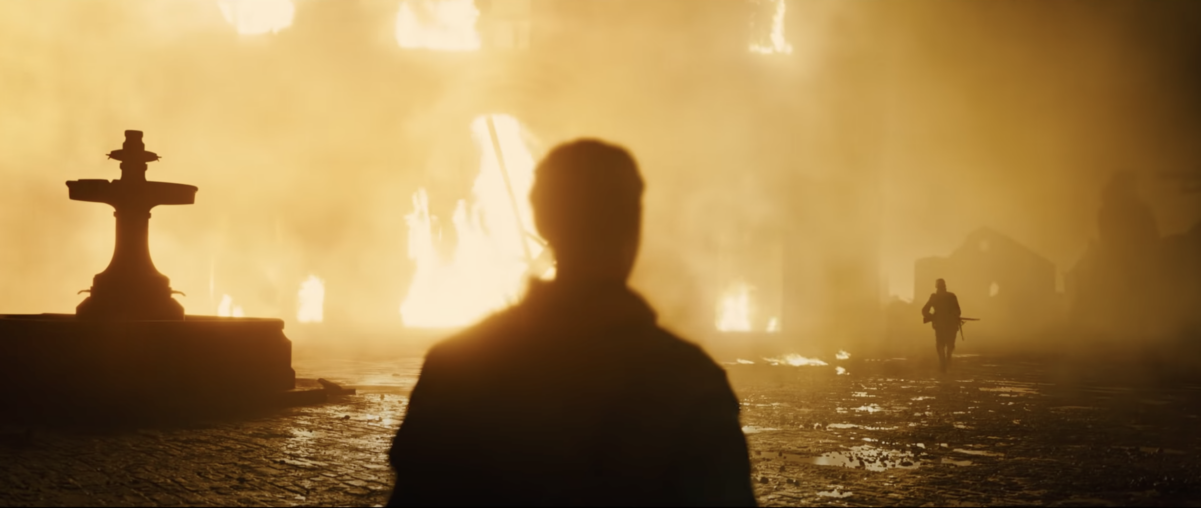The end of 1917 is curious because the audience is left unsure as to the fate of Will Schofield. This uncertainty is by design and has two primary mechanisms. One that creates the expectation of a negative outcome and the other that provides hope for a positive outcome.
First, let’s recap the final moments.
Mission complete
Will Schofield’s journey to stop the Second Battalion of the Devonshire Regiment from being slaughtered by a German trap is harrowing. He’s blown up, shot, nearly drowned, malnourished, dehydrated, and knocked over like a bowling pin several times by soldiers running full speed. It’s by sheer determination he survives both man and nature to save the 1,600 men of the 2nd Devons.
There’s so much tension throughout 1917, especially in the final 20 minutes, that we have a tremendous sense of relief when Will completes his broader mission of preventing the 2nd Devons from devastation. Then another wave of bittersweet satisfaction when he finds and informs Tom Blake’s brother of Tom’s passing.
Even the cinematography reflects this sudden tranquility after almost 2-hours of stress. We go from being in the trenches, to on the battlefield, to the medical tent with the wounded and dying and dead, to a stoic-yet-grieving Lieutenant Blake, to, finally, just Will. At this moment of calm, the camera maneuvers in a way that we only see grass, flowers, distant hills, and a single nearby tree. Will walks to that tree, sits against it, looks at photos of what we can assume are his wife and daughters, then closes his eyes.
The end.
Outcomes
There’s good reason to think that because Will has completed his mission he’s ready to let go, that the tolls of his journey have caught up with him. And he’s ready to pay the price. Remember when Tom was stabbed by the German pilot and bleeding out? When he realizes he’s dying, he pulls out a picture of his family and stares at it. Holds it close. It makes sense: you want the last thing you see to be your loved ones.
Because 1917 constructed that moment with Tom to be so poignant, it subconsciously primes viewers to associate that kind of picture-gazing with imminent death. Especially with how beat to hell Will was and him resting against the tree much like Tom, in his last moments, leaned against Will. These visual callbacks all serve to create and reinforce a sense that our hero is at death’s door.
But here’s the counter.
What’s written on the back of the photo of Will’s wife and daughters? A message that says, “Come back to us.”
In the first half of 1917, Tom appeared to be the main protagonist. To warn the 2nd Devons was his mission—it was his brother at risk. Will was only there because the general insisted Tom bring someone else along. We even have the scene where Will screams at Tom, frustrated at being forced into what seems to be an impossible, suicidal undertaking. It’s Tom who calms Will down and smooth talks him into continuing on. This scene reinforced the power dynamic between the two: Tom is our primary character, Will the secondary.
With Tom’s final breath, a transfer occurs. The mission, and the role of protagonist, passes to Will. And because Will’s now responsible for his friend’s legacy, it’s no longer just a mission. It’s personal.
All of this comes into play at the end of 1917. When Will looks at those photos, there is a very real implication he might die. Another of the many soldiers claimed by the machine we call war. There’s probably even the sense to some viewers Will wants to let go. That he’s tired and done his duty. But when he flips the picture over and reads those words—“come back to us”—it reminds him that there’s still a burden to bear. He’s still responsible to someone.
“Come back to us” is not a wish. It’s not a request. It’s a command. And Will has shown us how determined and capable he is once he has has his orders.
With that in mind, I think it’s safe to assume Will will rise. We don’t know if he’ll ever make it home. That’s the sad reality of war. But we know for damn certain he’s not the type to quit when someone’s counting on him.
Overall
Why end with that duality?
Narratively-speaking, endings tend toward conclusion or discussion.
For example, a movie like Argo is about Ben Affleck trying to save six American Embassy staff hiding from Iranian revolutionists who have already taken 60 others hostage. The bulk of the film is the planning, set-up, and execution of the rescue. At the very end, there’s no ambiguity—Affleck and co. save the six staffers. And Affleck, after a long time away, finally gets to return home to his wife and son.
Whereas a movie like Inception almost ends in the same way, with DiCaprio getting to return to his children after years of exile. But instead of giving us that satisfying conclusion, it ends with us questioning whether or not the moment of reunion was a fantasy or reality. This means we’re left to work through and discuss (internally or with others) the purpose of the ending, rather than just come away feeling satisfied.
1917 is closer to Inception than it is Argo. On the thematic-scale, Will represents the uncertainty of the soldier. As 1917 attempts to capture both the intimate and broad aspects of being a soldier (in World War I, yes, but in any war, really)—the persistent, nagging question, throughout time, is “Will the soldier make it home?” By leaving the viewer with that very question, the desire is that we experience, if even for a second, the uncertainty, sadness, and hope of a soldier and the loved ones of a soldier. That’s the vicarious power of fiction.

